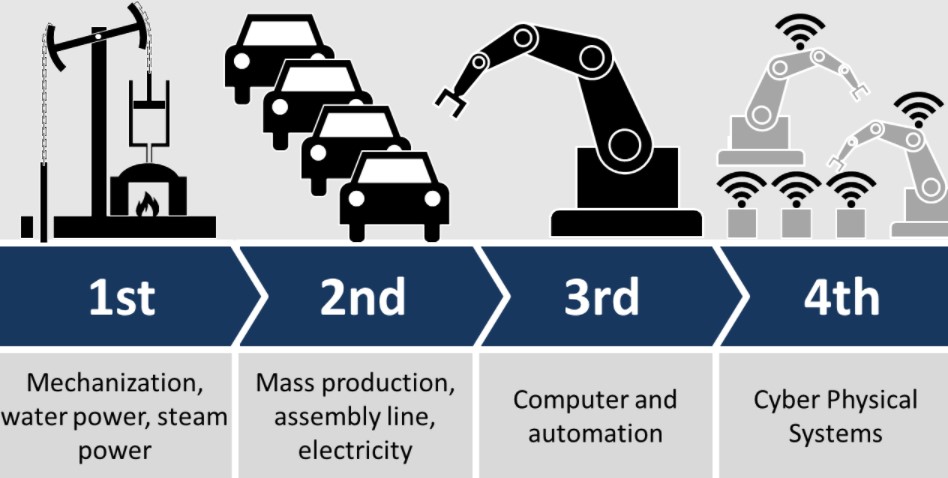Fourth industrial revolution
|
This illustration of Industry 4.0 summarises the four industrial revolutions. |
Contents |
[edit] Introduction
The fourth industrial revolution (also referred to as Industry 4.0 or Industrie 4.0) is a term used to describe the shift away from digitally automated manufacturing and industrial processes (that require human control) to smarter technologies that rely less on human intervention. The technologies of the fourth industrial revolution depend on machine-to-machine communications and the Internet of Things (IoT) to monitor and analyse operations within the manufacturing, industrial and business sectors.
[edit] Review of industrial revolutions
Since the mid-18th century, industrial revolutions were seen as periods where many new inventions led to significant changes in culture, infrastructure, business and related social advances. Each industrial revolution was characterised by specific innovations, including:
- First industrial revolution. Steam and water power were used to mechanise production.
- Second industrial revolution (also referred to as the technological revolution). Electricity was used to support mass production through the use of assembly lines.
- Third industrial revolution (also referred to as the digital revolution). Electronics and information technology have been used to digitise and automate processes.
- Fourth industrial revolution. Cyber physical systems (CPS) are used to enhance automation and connectivity introduced during the third industrial revolution.
[edit] History
In 2011, the term Industrie 4.0 (also referred to as I4.0 or I4) was introduced to describe an innovative computerised manufacturing strategy used by the German government. The term was introduced that year at the Hannover Fair.
Exploration of the concept was continued by the German government’s working group on Industrie 4.0. In October 2012, the group presented the German government with Industrie 4.0 implementation recommendations as a result of its work, and the final report of the group was presented at the Hannover Fair in 2013.
In 2015, the concept of the fourth industrial revolution was introduced at the World Economic Forum (WEF) by the German engineer and economist, Professor Klaus Schwab. Schwab (who is also the founder and executive chairman of the World Economic Forum), characterised the idea as a fusion of new technologies, blurring the lines between the physical, digital and biological worlds.
Mastering the Fourth Industrial Revolution was picked up as the theme of the WEF Annual Meeting in 2016. Its impact became one of the central themes of the WEF in 2017.
[edit] The fourth industrial revolution and the built environment
Mark Farmer's 2017 report, 'Modernise or die', looked forward to a fourth industrial revolution underpinned by cyber-physical smart production techniques, which it described as Industry 4.0. However, Farmer’s report acknowledged that in many respects, construction has yet to achieve Industry 3.0 status, which simply requires large scale use of electronics and IT to automate production.
Based on the progress of Industry 4.0, others suggest that the world might see the biggest industrial shifts in a generation, changing the way people work and live in the urban environment. As a result of greater technological advances, the built environment could see the physical world become ever more connected to the digital one through billions of sensors feeding back information through the IoT. This could result in new ways of serving customers, new capabilities in production and changes in the operation of devices across all sectors. Innovations such as 3D printing, artificial intelligence and advanced robotics could shift models of work and production in ways that are impossible to fully predict.
[edit] Related articles on Designing Buildings
- Are we doing the right thing? Shaping well-being into the future of our urban communities
- Can we build cities that anticipate the future?
- Internet of things.
- Modern methods of construction.
- Modernise or die.
- The Fourth Industrial Revolution is about to hit the construction industry. Here’s how it can thrive.
- The future of the built environment in a revolutionary age.
- The promise and peril of digital cities.
Featured articles and news
The UK's Modern Industrial Strategy: A 10 year plan
Previous consultation criticism, current key elements and general support with some persisting reservations.
Building Safety Regulator reforms
New roles, new staff and a new fast track service pave the way for a single construction regulator.
Architectural Technologist CPDs and Communications
CIAT CPD… and how you can do it!
Cooling centres and cool spaces
Managing extreme heat in cities by directing the public to places for heat stress relief and water sources.
Winter gardens: A brief history and warm variations
Extending the season with glass in different forms and terms.
Restoring Great Yarmouth's Winter Gardens
Transforming one of the least sustainable constructions imaginable.
Construction Skills Mission Board launch sector drive
Newly formed government and industry collaboration set strategy for recruiting an additional 100,000 construction workers a year.
New Architects Code comes into effect in September 2025
ARB Architects Code of Conduct and Practice available with ongoing consultation regarding guidance.
Welsh Skills Body (Medr) launches ambitious plan
The new skills body brings together funding and regulation of tertiary education and research for the devolved nation.
Paul Gandy FCIOB announced as next CIOB President
Former Tilbury Douglas CEO takes helm.
UK Infrastructure: A 10 Year Strategy. In brief with reactions
With the National Infrastructure and Service Transformation Authority (NISTA).
Ebenezer Howard: inventor of the garden city. Book review.
The Grenfell Tower fire, eight years on
A time to pause and reflect as Dubai tower block fire reported just before anniversary.
Airtightness Topic Guide BSRIA TG 27/2025
Explaining the basics of airtightness, what it is, why it's important, when it's required and how it's carried out.
Construction contract awards hit lowest point of 2025
Plummeting for second consecutive month, intensifying concerns for housing and infrastructure goals.
Understanding Mental Health in the Built Environment 2025
Examining the state of mental health in construction, shedding light on levels of stress, anxiety and depression.























